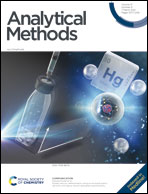An ultrasensitive colorimetric assay based on a multi-amplification strategy employing Pt/IrO2@SA@HRP nanoflowers for the detection of progesterone in saliva samples†
Abstract
Progesterone (P4) belongs to a factor that affects stress response and is a potential carcinogen, and saliva levels are expected to be a standard measurement for clinical diagnosis. In this study, a new type of nanoflower with both recognition functionality and catalytic substrate ability was prepared by copper phosphate, Pt/IrO2 nanocomposites (Pt/IrO2 NPs), streptavidin (SA) and horseradish peroxidase (HRP) via a one-pot co-precipitation strategy. Due to the enhanced catalytic activity and stability of Pt/IrO2@SA@HRP nanoflowers, we developed a powerful and sensitive multiple-catalysis ELISA to monitor progesterone in saliva. Multiple-catalysis ELISA based on a specific antibody and Pt/IrO2@SA@HRP nanoflowers exhibited a linear interval range from 0.217 ng mL−1 to 7.934 ng mL−1. The median inhibitory concentration (IC50) for progesterone is 1.311 ng mL−1 and the limit of detection (LOD = IC10) is 0.076 ng mL−1 in the proposed method. Satisfactory recoveries were in a range of 79.6–107% with an acceptable coefficient of variation (below 10.6%). Results of the multiple-catalysis ELISA and LC-MS/MS had a good coincidence. Our result unraveled that multiple-catalysis ELISA is a potentially serviceable tool for the detection of progesterone in saliva.



 Please wait while we load your content...
Please wait while we load your content...